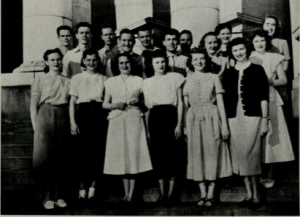BYU students commit to live the Honor Code. However, BYU hasn’t always had an Honor Code. Here are some major events that have contributed to BYU’s current Honor Code.
1876: After becoming the principle of Brigham Young Academy, Karl G. Maeser put in foundation for The Domestic Department. However, the organization wasn’t formally established until 1879.

1879: The Domestic Department created the “Domestic Organization,” which was a group of teachers who would monitor students when they were off campus to see that they were following the school’s moral rules (prohibiting obscenity, profanity, smoking and alcohol consumption).
1930s–1940s: There is an increase in standards regarding student housing and the dress code. For example, women were only allowed to wear pants on Saturdays, and men wore uniforms for a short time.
1948: The Honor Code is initiated and written by the BYU chapter of the Blue Key National Honor Fraternity and White Key organization. The document dealt specifically with academic honesty and established a committee that dealt with violators of the code.
1949: The Student Honor Council oversaw case violations. This council succeeded in alleviating cheating among students.

1955: Student support for the Honor Code weakened because of the code’s “strict legalistic approach.” This led the student-run Honor Code Committee to revise its approach to be more counseling-based.
1957: BYU president Ernest L. Wilkinson suggested the Honor Code expand to include not just standards relating to academic honesty,but also other school standards. This led to the expansion of the Honor Code in the 1960s, which created the bulk of what the Honor Code represents today: rules regarding chastity, dress, grooming, drugs and alcohol.
1960s: Several rules regarding longer hairstyles in men were introduced, as well as rules regarding women’s dress. Church leaders made statements against low-cut dresses and short skirts. For men, however, long hair and beards were not completely against the code until the mid-1970s. By this time, women were allowed to wear slacks and pant-suits, but jeans were not allowed until 1981.

1968: The administration took over the Honor Code, making it no longer student-run. In an article written for BYU Today in 1992, current university spokeswoman Carri Jenkins said, “Since this is during the height of Vietnam protest era the Honor Code was completely rewritten to include requirements to respect national, state and other duly appointed authority, to register all student organizations, to not enter or occupy university facilities without authorization, and to not use psychedelic drugs.” At this point, the Honor Code was in list format, varying from seven to 15 rules. Also, the Honor Code Committee and Student Senate were disbanded.
1972: A list of 12 rules and an accompanying dress code received the approval of the Board of Trustees.
October 1990: An ad hoc committee was formed, consisting of faculty, administrators and students. Their goal was to study BYU’s Honor Code and Dress and Grooming Standards and discover what the BYU community thought about the Honor Code. The committee’s purpose was not to change the code but to make it more understandable.
March 1991: A revised version of the Honor Code was approved by the Board of Trustees. The revised version emphasized general principles rather than rules. The revision made a distinction between the Honor Code and the dress and grooming standards. The Honor Code had an incorporation clause: “I will follow all other rules and regulations of the university.”
2007: BYU reworded its Honor Code to clarify policy on homosexual behavior.
March 2008: The University of Texas at San Antonio was ironically accused of plagiarizing a portion of BYU’s Honor Code related to cheating and plagiarism.
2014: BYU decided it will no longer answer media questions about athletes who violate the Honor Code.
Aggregated from:
Wikipedia Article: “Brigham Young University Honor Code”
L. Tom Perry Special Collections online: Brigham Young University Honor Code
“On Your Word of Honor,” by Carri P. Jenkins
J. Gordon Daines, university archivist; assistant department chair, manuscripts
The Universe article: “BYU will no longer disclose athletes’ Honor Code violations”




